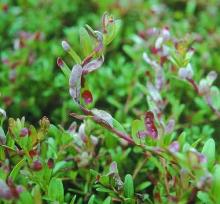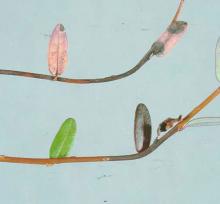See:
Cranberry (Vaccinium macrocarpon) - Red Shoot
Cranberry (Vaccinium macrocarpon) - Rose Bloom
Cause Exobasidium rostrupii, a fungus. Disease may be severe on newly planted vines treated with high-nitrogen fertilizers for rapid growth during the first and/or second year. Shaded areas with poor air circulation may contribute to disease development. Fruit buds and blossoms injured by frost or insects are very susceptible. Symptoms may appear during rainy (misty), cloudy weather beginning in midsummer on new growth.
Symptoms One or several glossy red spots appear on the upper leaf surface. Spots may coalesce to form large blotches. The lower leaf surface is covered with cream-color spores beneath the spots. The petiole and stem may become infected, enlarge, and turn red. If severe, terminal growth of the uprights and runners dies, and the next crop is reduced. Fruit is attacked occasionally. Reddened tissues often turn black as they are invaded by the black spot fungus, Ramularia nigromaculans (formerly Mycosphaerella nigromaculans). In combination, the two diseases occasionally do serious damage but only when the incidence of red leaf spot has been high.
Cultural control
- Use a controlled nitrogen fertilizer program.
- Remove trees around the bed to decrease shade and improve air circulation.
- Protect from frost and insect damage.
Chemical control Mancozeb, or fixed-copper products applied to control fruit rots also controls red leaf spot. Fungicides applied in July and August to control fruit rots will keep the black spot fungus in check.
Reference Polashock, J.J., Caruso, F.L., Averill, A.L., and Schilder, A.C. 2017. Compendium of Blueberry, Cranberry and Lingonberry Diseases and Pests. Second edition. St. Paul, MN: APS Press.




